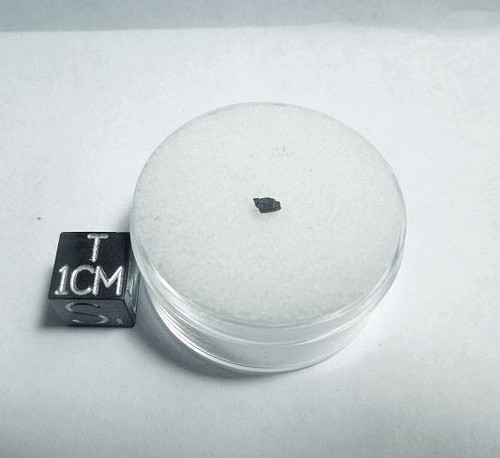NOTE (Jan 12, 2o25) - the photo and description for this listing has been updated.
Aletai is a massive iron meteorite find that originates from China. It is an interesting meteorite because it was relatively unknown to western collectors until recently when Chinese dealers flooded the market with trinkets and jewelry made from the meteorite. It is a rare type of iron meteorite (IIIE-an) which is one of only two known and the only one available to collectors.
The specimens being offered here are small flakes and plates that spalled off from a larger mass. They are partially oxidized, but not totally rusted.
Refer to the photo. The black centimeter cube is shown for scale and is not included. You are purchasing a single small fragment like the one shown. Your purchase will include a labeled gemjar for safe storage.
From the Meteoritical Bulletin entry on Aletai :
Chemical and petrographic analyses of multiple iron meteorite masses in the northern part of Xinjiang Uyghur Autonomous Region, China, indicate pairing of these masses with the Armanty (IIIE) iron. All of these iron meteorites, as well any paired material that may be discovered in the future, will henceforth carry the official name “Aletai,” the name of a local county. The names “Armanty,” “Xinjiang (b),” and “Xinjiang 008” (a provisional name) are now abolished, and become synonyms for Aletai. In a previous action (MetBull 95), the name “Ulasitai” was abolished, and made a synonym for Armanty; “Ulasitai” will now become a synonym for Aletai.
This entry also corrects previously published coordinates for the 28 tonne Armanty mass, announces several new masses, and presents compositional data by J.T. Wasson, UCLA, for five of the paired masses. The masses form a NW-SE array, spanning approximately 425 km across China and a sliver of Mongolia (although no masses have been reported from Mongolia).
The new nomenclatural system for these irons is analogous to the grouping, some decades ago, of previously named IIAB irons under the name “North Chile.” When referring generally to the irons, authors should use the names “Aletai” and “North Chile.” When referring to a specific mass, authors should identify it as, for example, the "Armanty mass of Aletai" or the "Filomena mass of North Chile." The list of recommended mass names for Aletai appears in the table below.
The coordinates listed for this entry correspond to the corrected location at which the Armanty mass was discovered.
Discovery of the Wuxilike mass of Aletai:
History: A large iron was found by a local farmer in a valley in a mountainous area of Aletai County. It was surrounded by rocks and half buried. A small specimen was taken for analysis. Heavy machinery was used to move the meteorite from the valley to the discoverer’s home. Physical characteristics: The kamacite bandwidth is 0.89±0.41 mm. Petrography: The major phases of the meteorite are kamacite, taenite, and plessite. Minor phases include schreibersite, daubréelite, troilite, and haxonite.
Discovery of the Akebulake mass of Aletai:
An account of the discovery of this large iron mass in a remote mountainous region was published by Beatty (2011) based on a trip there by Ayisha in June 2011. It has an irregular surface with partial regmaglypts but has been severely affected by terrestrial weathering. The iron is dark-brown; it was partly covered by a granite slab on the side of a mountain. Its exterior was marked by several scrawls of graffiti and cuts. Aletai City officials worried that the meteorite would be further damaged they built a road and moved the Akebulake mass to the Aletai city hall in 2011.
Table 1. Known masses of Aletai.
Analyses by J. T. Wasson, UCLA, See MetBull 104 for an analysis of Xinjiang (b). Aletai is an anomalous IIIE. It has the highest Au concentration in the group, and its Ir concentration is much higher than that inferred through the trend of the other group members.
|
Mass name |
mass |
Latitude |
Longitude |
|
Co |
Ni |
Cu |
Ga |
As |
W |
Ir |
Au |
|
|
|
(N) |
(E) |
|
mg/g |
mg/g |
µg/g |
µg/g |
µg/g |
ng/g |
µg/g |
µg/g |
|
28 t |
45°52.272' |
90°30.279' |
|
5.15 |
97.8 |
109 |
16.9 |
14.4 |
0.28 |
0.228 |
1.810 |
|
|
Akebulake |
18 t |
48°6.25' |
88°16.57' |
|
5.17 |
98.8 |
110 |
16.9 |
15.1 |
0.32 |
0.224 |
1.814 |
|
Wuxilike1 |
5 t |
48°3.13' |
88°22.32' |
|
5.20 |
98.0 |
105 |
17.0 |
15.8 |
0.26 |
0.234 |
1.862 |
|
0.43 t |
44°57'24" |
91°24'09" |
|
5.21 |
96.9 |
108 |
16.7 |
15.0 |
0.28 |
0.235 |
1.894 |
|
|
35 kg |
47°58.7' |
88°13.1' |
|
|
|
|
|
|
|
|||
|
(unnamed) |
15 kg |
(see note 4) |
|
|
5.22 |
93.2 |
95 |
16.4 |
15.5 |
0.31 |
0.230 |
1.855 |
1 Was given the provisional name Xinjiang 008
2 Published in MetBull 90 as a distinct meteorite
3 Published as a distinct IIIAB iron in MetBull 104
4 Found in the Xiaodonggou region close to the place where Wuxilike and Akebulake were found





